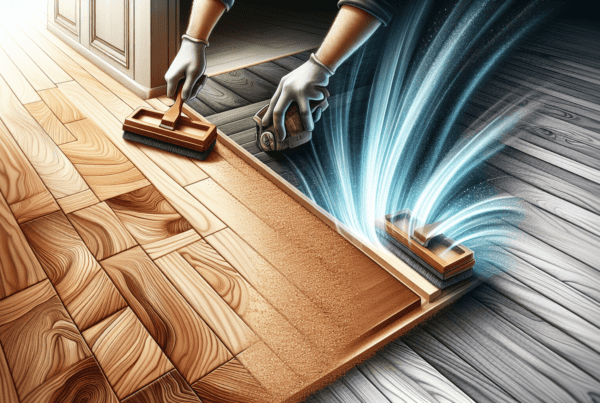In today’s article, we’re thrilled to explore the exquisite craftsmanship of Wellington Timber Floor Sanding & Finishing Perfection. Renowned for transforming ordinary wooden floors into breathtaking works of art, this team’s dedication to quality and detail has earned them a stellar reputation in Wellington and beyond. Through their expert sanding and finishing techniques, they uncover the hidden beauty of timber floors, bringing out the warmth and character that lie beneath. Join us as we celebrate the artistry and skill that make Wellington Timber Floor Sanding & Finishing Perfection a true leader in their field.
Understanding Timber Floor Sanding
Definition and Purpose
Timber floor sanding is a crafting process we undertake to rejuvenate and restore wooden floors. By removing the top surfaces of a wooden floor through abrasive sanding, we can eliminate old finishes, dirt, and imperfections. The purpose is simple yet profound – to bring out the natural beauty and grain of the wood, preparing it for refinishing that not only enhances its appearance but also protects it.
Benefits of Sanding Your Timber Floor
Sanding your timber floor comes with a plethora of benefits. Firstly, it significantly improves the look of your floors, giving your space a fresh and inviting atmosphere. Secondly, it increases the durability of the floors by removing any damaged wood and allowing for a new protective finish. Sanding also creates a smooth surface that’s easier to clean and maintain. Finally, it adds value to your property by making your floors look brand new.
The Sanding Process: An Overview
The sanding process involves meticulously moving sanders across the timber floor in a controlled manner. We begin with coarse grit sandpaper to remove the old finish and surface damage, gradually moving to finer grits to smooth out the wood. Along the way, we take special care of tricky areas and edges, ensuring a uniformly smooth surface. Once the sanding is complete, the floor is vacuumed and cleaned, preparing it for the finishing touches.
Types of Timber Floors Suitable for Sanding
Solid Wood Flooring
Solid wood flooring, a classic choice among homeowners, stands out for its durability and longevity. Its thickness allows for multiple rounds of sanding and refinishing, making it an ideal candidate for restoration projects.
Engineered Wood Flooring
Engineered wood flooring, composed of a real hardwood veneer atop multiple layers of plywood, can also be sanded, albeit with a bit more caution due to the thinner wear layer. Depending on the thickness of the veneer, it can usually withstand at least one sanding and refinishing process.
Parquet Floors
Parquet floors, with their unique geometric patterns, can be sanded to restore their intricate beauty. However, due to the direction of the wood grains in the design, a more careful and skilled approach is necessary to achieve the best results.
Choosing the Right Sanding Equipment
Belt Sanders vs Orbital Sanders
When deciding between belt sanders and orbital sanders, it’s essential to understand their differences. Belt sanders are powerful tools that remove old finishes and materials quickly, ideal for the initial sanding stages. Orbital sanders, on the other hand, are more suitable for the final stages of sanding, providing a finer finish due to their circular sanding motion.
Sanding Paper Grit Recommendations
Choosing the right sandpaper grit is crucial for achieving the desired finish. We start with a coarse grit (around 40-60) for removing old finishes, then move to a medium grit (80-120) for smoothing the surface, and finally, a fine grit (150-180) for the finishing touches. The key is to progress gradually to avoid damaging the wood.
Safety Equipment and Precautions
Ensuring safety during the sanding process is paramount. We always use protective gear, including dust masks, safety goggles, and ear protection. Additionally, it’s essential to ensure proper ventilation in the workspace to avoid inhaling dust particles.
Pre-Sanding Preparation
Clearing the Workspace
We begin by thoroughly clearing the workspace, removing furniture and any other items from the area. It’s crucial to have a blank slate to ensure the sanding process is efficient and unhindered.
Floor Inspection and Repair
Before sanding, we inspect the floor for any damages, such as cracks, dents, or loose boards. These issues need to be repaired or replaced to guarantee a smooth and consistent sanding process.
Cleaning the Timber Surface
Cleaning the timber surface of any dirt, debris, or old nails is the next step. This preparation ensures that the sanding equipment functions optimally and prevents any accidental damage.
The Sanding Process Step-by-Step
Starting with Coarse Grit Sandpaper
Using coarse grit sandpaper, we tackle the bulk of the sanding work, removing old finishes and evening out the surface. This step requires patience and attention to ensure uniform removal across the entire floor.
Progressing to Medium and Fine Grit
Gradually, we progress to medium and fine grit sandpapers to refine the surface. This progression is essential for achieving a smooth and even finish, ready for the final refinishing touches.
Dealing with Difficult Areas and Edges
Difficult areas and edges often require hand sanding or the use of smaller sanding tools. We take special care in these areas to ensure they blend seamlessly with the rest of the floor.
Choosing the Right Finish for Your Timber Floor
Types of Finishes Available
When it comes to finishing your timber floor, there’s a wide array of options, including polyurethane, oil-based finishes, and water-based finishes. Each type offers different aesthetics and levels of protection.
Factors to Consider When Choosing a Finish
Choosing the right finish involves considering the room’s usage, desired maintenance level, and the specific look you’re aiming for. For example, water-based finishes dry quickly and have a minimal odor, making them ideal for quick renovations.
Application Tips for a Smooth Finish
For a smooth finish, it’s vital to apply the finish evenly and allow plenty of drying time between coats. It’s also beneficial to lightly sand between coats to ensure a flawless final layer.
Applying the Finish
Preparation for Finishing
Preparation is key when applying the finish. We make sure the sanded floor is clean and free from dust. Applying a primer or sealer, depending on the finish type, can also enhance the final outcome.
Techniques for Even Application
Using the right application technique is essential, whether it’s brushing, rolling, or spraying. We always follow the wood grain for a natural look and apply consistent pressure for an even coat.
Drying Times and Ventilation
Allow sufficient drying times between coats and ensure good ventilation in the area. This not only speeds up the drying process but also prevents any dust from settling on the wet finish.
Maintenance Tips for Your Timber Floor
Regular Cleaning Practices
Regularly cleaning your timber floor with suitable products can prolong its life and maintain its beauty. Avoid using water or harsh chemicals that can damage the wood and the finish.
Repairing Scratches and Dents
For scratches and dents, minor repairs can often be done with a matching wood filler or a touch-up kit specifically designed for wooden floors.
Re-Sanding and Re-Finishing Periods
Depending on the traffic and wear, your timber floors might need re-sanding and refinishing every 7-10 years. This rejuvenates the wood and protects it for years to come.
Hiring Professionals vs DIY
When to Hire a Professional
Considering the complexity and the equipment required for sanding and refinishing floors, hiring a professional might be the best option, especially for large areas or intricate floors.
Cost Considerations
While DIY might seem cost-effective, professional services ensure a high-quality finish that lasts longer, potentially saving money in the long term.
Finding a Reputable Service in Wellington
When looking for timber floor sanding and finishing services in Wellington, seeking recommendations, and checking reviews are great ways to find reputable professionals who can deliver the desired results.
Case Studies: Before and After Timber Floor Sanding and Finishing in Wellington
Home Renovation Projects
Numerous homes in Wellington have seen remarkable transformations with timber floor sanding and refinishing. The restoration of original floors brings warmth and character back to the spaces, enhancing the home’s overall appeal.
Commercial Flooring Transformations
Commercial spaces, too, benefit from the professionalism of Wellington timber floor sanding services. Revitalized floors in restaurants, offices, and shops elevate the ambiance for both employees and customers, contributing to a positive image of the business.
Feedback and Testimonials from Wellington Residents
Residents of Wellington consistently express their satisfaction with the quality of work provided by local timber floor sanding and finishing professionals. The dramatic improvements in their floors’ appearance and durability stand as a testament to the craftsmanship and attention to detail these experts bring to every project.







